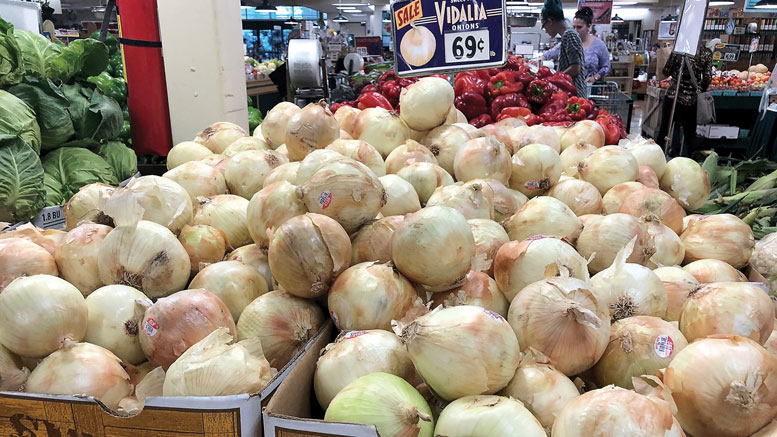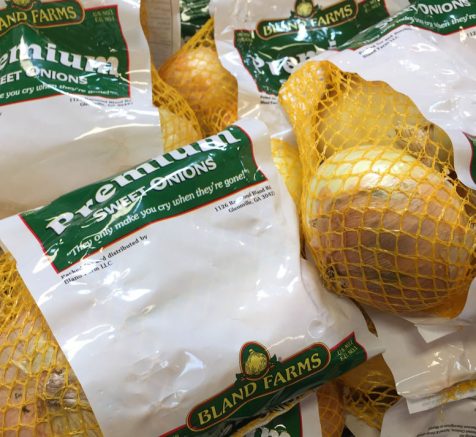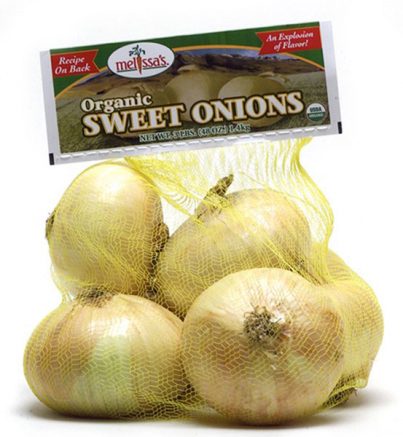Powerful Sweet Onions Sales Machine
May 18, 2021 | 10 min to read
Effective merchandising of flavorful onions, particularly sweet onions, can significantly boost sales and profits for retailers. Renowned for their mild flavor, sweet onions like Vidalia and Walla Walla drive consumer interest year-round, with sales increasing even during the pandemic. Retailers are encouraged to create large, eye-catching displays and cross-merchandise them with complementary items to maximize visibility and impulse purchases. With demand steadily growing, sweet onions should hold a prominent place in produce sections for continued success.

Effective merchandising of flavorful onions can elevate sales and help drive profits throughout stores.
Originally printed in the April 2021 issue of Produce Business.
Sweet onions help dishes sparkle and encourage consumers to fill their shopping carts with other store items. As one of the biggest ingredients of the onion category, sweet onions are critical for attracting shoppers to the onion section. Through effective merchandising, retailers can upsell even more of them.
“Sweet onions are one of the biggest sales categories in onion sales in the United States,” says Rene Hardwick, director of public and industry relations for the National Onion Association (NOA), Greeley, CO.
While Georgia’s Vidalia onions possess the highest name recognition, consumers crave sweet and mild onions throughout the year from a variety of regions. Sweet onions are also grown domestically in Texas, Nevada, California’s Imperial Valley as well as in New Mexico and in other areas. Because they offer the flavors of their specific areas in which the locals take pride, sweet onions define entire communities, such as the Walla Wallas and Vidalias. A recent entry, Yensis sweet onions from Palmer, Alaska, experience a short growing season in fine Glacial silt soil.
“All onions, whether sweet, yellow, red or white, should be merchandised together, offering a choice for shoppers,” says Mike Blume, director of sales and marketing for Keystone Fruit Marketing, in Greencastle, PA. “During certain times of the year, secondary displays of sweet onions, loose and or in bags, are a great option for merchandising and a great way to generate additional impulse sales.”
Of the major onion varieties, sweet onions trail only yellow onions in unit sales. The less pungent onions account for 32% of sales in the main onion category and 25% of the entire onion category, which includes green onions, pearls, shallots and other specialties, according to Chicago-based researcher The Nielsen Company.
PREMIUM PRICE
Sweet onions are priced a little higher than yellow onions because they are hand-planted and harvested, notes Troy Bland, chief executive officer of Bland Farms LLC, Glennville, GA. “Sweet onions are a ‘must’ for retailers to have available for their customers, as the demand for sweet onions continues to grow,” he says. “Because the sweet onion is now available all year, as opposed to seasonally, consumers consistently look for and crave the sweet mild flavor. This keeps demand high for retailers year-round.”
Kicking off the U.S. sweet onion season, Texas 1015s typically begin shipping in March and ship to July 4th. Vidalias usually start by mid- to late April and are sold fresh through Labor Day. Walla Walla sweet onions typically harvest in mid-June and end mid-August. The offshore deal commences in late summer and early fall with Peru. Mexican sweet onions begin in February.

“Consumers wait eight months for Vidalia onions to hit store shelves and when they do, they bring a lot of excitement to the produce department,” notes John Shuman, president of Shuman Farms, Inc., based in Reidsville, GA. “We believe that one of the key factors in maintaining excitement for Vidalia onions is to connect customers with the story and the history of this unique item. We know that retailers’ produce teams are the first line of communication with consumers and so ahead of the season, education is key.”
People tend to be partial to the sweet onions grown in their region, observes Cindy Elrod, sales and new business development for Peri & Sons Farms, Inc., headquartered in Yerington, NV. “Retailers should take every opportunity to highlight the seasonal changes in sweet onion varieties with bountiful displays, signage and special promotions at the beginning of each season,” she says. “Sweet onions range from over 25% to 50% of total onion sales, showing they are a shopper favorite and generate additional sales. Sweet onions also command a higher ring at the register than other varieties. Bottom line: sweet onions should always have a preferred position in the produce department due to their ability to produce additional sales and profits.”
At W. Lee Flowers & Co., Inc., a Lake City, SC-based wholesale grocery company that supplies and operates IGA stores and independent supermarkets throughout the South, sweet onions mean big sales. “The interest in sweet onions has helped us grow the category,” says Mychael Thomas, director of produce. “We are seeing some same-store increases on sweet onions over the last few years. We are advertising the category more than we did in the past.”
PANDEMIC PROOF
Sweet onions fared well during the past year, experiencing sales increases during the pandemic. For the 52-week period ending March 20, sweet onions increased in dollar sales by 22% compared to the previous year and more than twice as much as the overall produce department, according to Nielsen. In unit sales, sweet onions expanded last year by 16%, more than double the overall produce department.
Sweet onions can market with margins as high as 100%, notes Mark Breimeister, sweet onion specialist with Potandon Produce LLC, Idaho Falls, ID. “Sweet onions are an increasingly important item at retail, just as all onions are,” he says. “As American cuisine becomes more diverse, the onion has played a larger role in cooking. I’ve been told that over 80% of recipes call for onions.”
Melissa’s/World Variety Produce, Inc., based in Los Angeles, CA, has experienced double-digit growth in sales of its Perfect Sweet branded onions, Maui sweets, cipollinis, boilers, pearls, organic and other specialty sweet onion varieties. “Sweet onions are an important part of the onion mix, and they make up about 15% of the onion category on average,” says Robert Schueller, director of public relations. “However, during the peak of season, spring to early summer, it is at 25% of the category.”
With people yearning to go outdoors during the pandemic, sweet onions should play an important role in spring and summer cookouts and family gatherings. “Sweet onions are incredibly important,” says Dante Galeazzi, manager of the Mission, TX-based South Texas Onion Committee and president and chief executive officer of the Texas International Produce Association. “As more and more consumers get into cooking at home, as we have seen throughout the pandemic, the sweet onion will be the most versatile of your onions. It allows you to have an onion that can be used fresh and cooked.”
Sweet onions are a summertime favorite. “If you look at the data, it has shown sweet onions are growing in market share for retailers year over year,” notes Michael Locati, chairman of the Walla Walla Sweet Onion Marketing Committee, Kennewick, WA, and owner and operator of Walla Walla, WA-based Pacific Agri Farms and Walla Walla River Packing and Storage. “You see more and more SKUs (stock-keeping units) getting tighter and tighter, so sweet onions are very important to retailers, who can get a premium for them, the Walla Walla sweet onions.”
BIGGER IS BETTER
To effectively merchandise sweet onions, retailers must erect significant displays. “Large displays drive sales,” advises Breimeister. “If a retailer chooses to sell loose onions in a large display, they will reap the benefits of increased sales over a retailer that chooses to only put out a small basket of sweet onions. Sweet onions are pretty much a nuts-and-bolts produce item and by far the bulk sweet onion display drives sales.”
A key to maintaining interest is constructing effective displays. “We encourage retailers to change displays and build excitement with each new season,” says Bland Farms’ Bland. Vidalia season, for example, should be made an event each year. Last year, Bland’s SpongeBob movie campaign proved successful. “Bland Farms strives to keep things exciting for both our retailers and consumers,” says Bland. “Creating displays and engaging consumers helps lead to increased sales, and the SpongeBob promotion did both. We look forward to running similar campaigns in the future to continue increasing sales at the retail level.”

Schueller recommends six-foot displays during peak season and four- to five-foot sections outside of peak. He also recommends end cap promotables in front of displays. “Make a big and wide section for the onion category close to or displayed next to variety potatoes,” says Schueller. “With potatoes, sweet onions are a natural fit.”
End caps can help sales, says Peri’s Elrod. “To maximize and produce measurable lifts in sweet onion sales, plan to give sweet onions premium shelf space on end caps, eye level shelves and in-front store displays,” she says. “Consumers want sweets year-round, and they have shown they are willing to pay a premium for a truly good, sweet onion. This gives retailers a lot of leeway for pricing sweets and being creative with ads.”
Shuman offers high-graphic secondary display bins that can be easily placed in produce and meat departments. “These offer customers the perfect add-on item to what they are already putting in their baskets,” says Shuman. “The Vidalia season starts in late April, just in time for grilling season. Vidalia onions pair perfectly with grilling meats and vegetables, including peppers, mushrooms, fresh beef and more.”
SALES MAGNET
Cross-merchandising sweet onions helps lift sales all over the store. Year-round sweet onions can and should be cross-merchandised in the meat department with hamburgers, sausages and steaks. “Not only will it increase sweet onion sales, it will help entice additional sales in the meat department as well,” says Keystone’s Blume. “Cross-merchandising year-round sweet onions with tomatoes, peppers, salads and squash will entice additional sales throughout the produce department. Be creative. Onions have a very high household penetration, so most people are looking for different ways to enjoy year-round sweet onions.”
Based on consumer research, merchandising Vidalia onions throughout the produce department is important to maximize sales, notes Shuman. “Merchandising solutions to meet consumers’ needs are vital for success, and Vidalia onions are an important part of the equation,” he says. “We recommend retailers create secondary displays throughout the produce department and store that complement items such as bagged salads, peppers, mushrooms, potatoes and tomatoes as the versatility and mild flavor of a Vidalia onion allow it to be the perfect ingredient for any dish.”
“Onions are a pantry item, but sweet onions should be a distinguishing pantry item.”
– Dante Galeazzi, South Texas Onion Committee
Sweet onions work well in merchandising with watermelons and cooking vegetables such as asparagus and Brussels sprouts. “Adding a sweet onion to those items will change up that flavor profile,” says Galeazzi. “It will really make the plate pop and will allow those other flavors to work together and provide some very mild notes as compared to the more pungent notes experienced from other varieties consumers have had during the past three to four months. Whenever you look at onions, you want to be thinking about cross-merchandising. Onions are a pantry item, but sweet onions should be a distinguishing pantry item. Everyone has potatoes, but then they go for the fingerlings, the golds and the sweet potatoes. Sweet onions are that distinction in the category.”
Providing simple recipe suggestions next to food items in other departments can show shoppers how to make better dishes, including suggestion cards promoting diced onions next to canned green beans.
“It could spark a new trend in eating,” says NOA’s Hardwick. “Even if you are eating out of cans, you can add onions to make it that much better and more nutritious. If you put down a can of green beans to your date’s plate, mixing in some garlic and diced onions makes it look like you worked extra hard on the meal.”

As the lockdowns helped move more packaged produce, sweet onions benefited. “COVID greatly impacted us last year, and we are expecting a similar outcome this upcoming season,” notes Bland. “As people started cooking at home rather than going out to restaurants, we saw an increase in sales for our Vidalia onions. Vidalias are not prevalent within restaurants, so this shift toward cooking at home increased exposure for our onion. Once people tried them, they were hooked. Though a relatively mature category, demand for our sweet onions is always strong and there are no signs that this will change in the near or distant future.”
As the pandemic took hold, bagged product demand took off, reports Potandon’s Breimeister. “I believe that trend has reversed a bit and the loose bulk display has continued to dominate sweet onion sales,” he says. “Because of the success of the category, they are now an item the consumer looks for, and the consumer has become more sophisticated. They know what to look for in sweet onions and are learning the difference between a quality sweet onion and an impostor.”
The future looks bright for sweet onion consumption. “I think sweet onions are on the move,” says Walla Walla’s Locati. “With more people shopping at grocery stores and eating at home, making their own meals and not eating out as much, produce consumption has been good, fortunately,” he says. “A lot of things suffered, but we are very fortunate that sweet onions overall have done well.”
13 of 17 article in Produce Business May 2021

